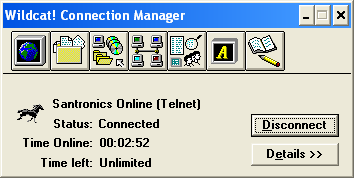The latest development fad today are "widgets". Google has them, Yahoo has them, Adobe has them, Microsoft has them. Each is doing it in their own ways with their own set of API toolchest:
o Microsoft - ActiveX, .NET and now SilverLight
o Google - A new comer Web Toolkit
o Yahoo - A new comer, Yahoo Widget API
o Adobe - Flash, Flex and now Apollo

For Wildcat! people, Wildcat! Navigator is a perfect example of "widgets" on your desktop. The above are all basically designed under the same idea as was done for over 10 years with your desktop Wildcat! Navigator (WCN) client or your html Wildcat! Web Clients:
Each of these WCN client are design with a single source API/SDK system. When using the Web, you can also display the clients in separate pages, making them appear as "widgets."
Widgets, smidgets! Maybe we will start calling Wildcat! Client as Widgets! :-)
The beauty of WCN clients is that under Wildcat! communications framework, the WCN clients can work with any connectivity device; WEB, GUI and TEXT mode!
So for those who believe "Social Networking" and "Widgets" were just recently invented with the Web, think again. This stuff existed for at least 20 years in the BBS world. You should know that the popular ONE ISPCON trade show was once called ONE BBSCON before the Internet exploded.
If you are interested, click on one of the WCN client links to see Wildcat! Client "Widgets" in action.
If you have Wildcat! Navigator (WCNAV) installed, your browser will start the desktop client. If you don't have WCNAV installed, you will see the web client. The chat client under the web, will start a JAVA desktop client. For text, you have to login under Telnet mode or Dialup. (For people who don't have an account on our system, try using the GUEST account - userid: guest pwd: guest).
Anyway, I think we will explore using Apollo/Flex to "glorify" Wildcat! Navigator clients. A technical challenge for us would be to see how we will bridge the Wildcat! RPC (WCRPC) communications framework with the various AJAX stacks and APOLLO for Java-based clients. A XML/RPC bridge might work but I haven't decided which way would be the best. Here is a drawing that illustrates the Wildcat! RPC framework showing some of the current industry considerations for Google Web TookKit, SPRY, Flash, SilverLight on the web side, and Apollo/Flex on the java side of the desktop.
Finally, to help us decide which way we should focus, I took a small quick survey to see how people are connecting to a Wildcat! system or to read mail. It was a stupid question because people who connected via their favorite method indicated as such the device they were currently using - DUH! However, what I found very interesting is that the response was spread across the board - the market is there for all the device type of connection devices.
No comments:
Post a Comment